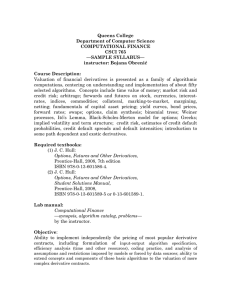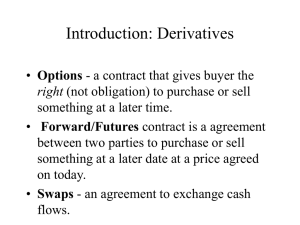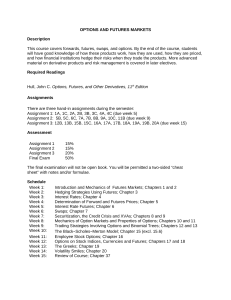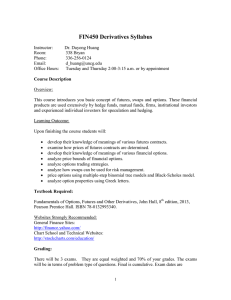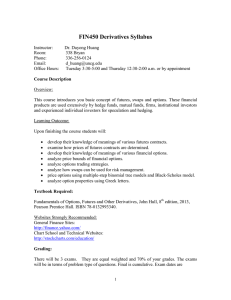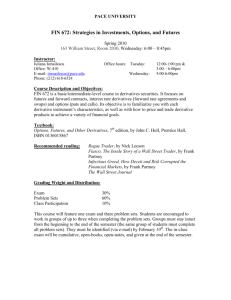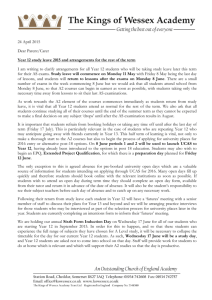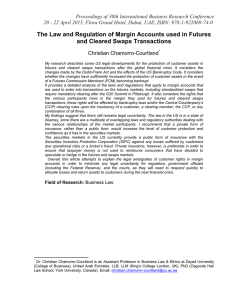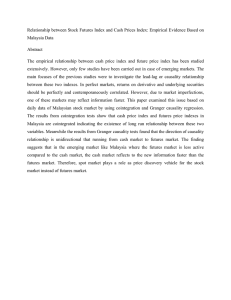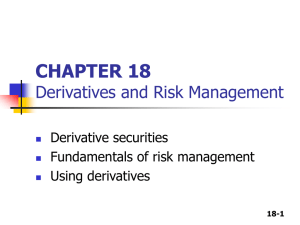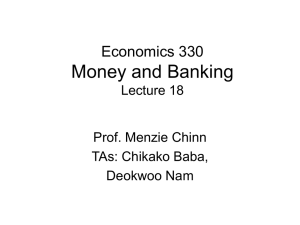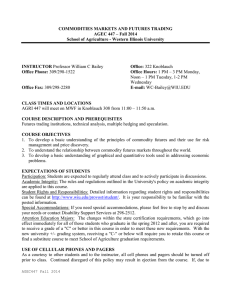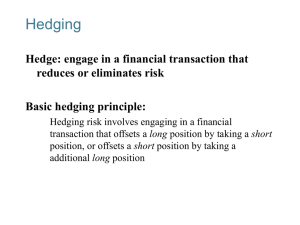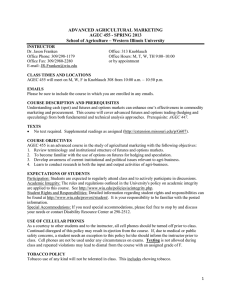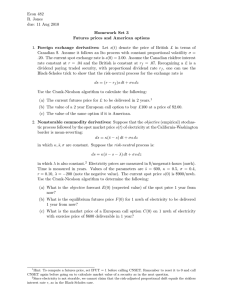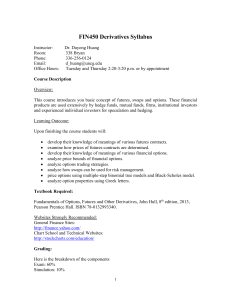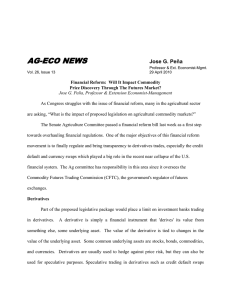OR 588 - SEOR - George Mason University
advertisement
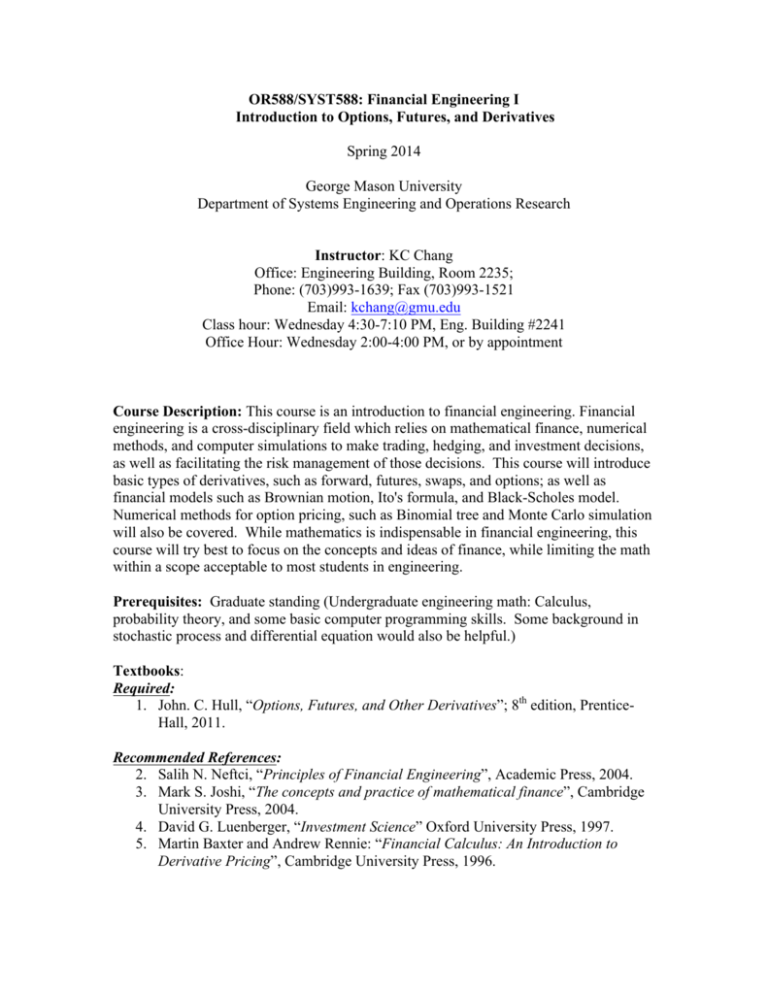
OR588/SYST588: Financial Engineering I Introduction to Options, Futures, and Derivatives Spring 2014 George Mason University Department of Systems Engineering and Operations Research Instructor: KC Chang Office: Engineering Building, Room 2235; Phone: (703)993-1639; Fax (703)993-1521 Email: kchang@gmu.edu Class hour: Wednesday 4:30-7:10 PM, Eng. Building #2241 Office Hour: Wednesday 2:00-4:00 PM, or by appointment Course Description: This course is an introduction to financial engineering. Financial engineering is a cross-disciplinary field which relies on mathematical finance, numerical methods, and computer simulations to make trading, hedging, and investment decisions, as well as facilitating the risk management of those decisions. This course will introduce basic types of derivatives, such as forward, futures, swaps, and options; as well as financial models such as Brownian motion, Ito's formula, and Black-Scholes model. Numerical methods for option pricing, such as Binomial tree and Monte Carlo simulation will also be covered. While mathematics is indispensable in financial engineering, this course will try best to focus on the concepts and ideas of finance, while limiting the math within a scope acceptable to most students in engineering. Prerequisites: Graduate standing (Undergraduate engineering math: Calculus, probability theory, and some basic computer programming skills. Some background in stochastic process and differential equation would also be helpful.) Textbooks: Required: 1. John. C. Hull, “Options, Futures, and Other Derivatives”; 8th edition, PrenticeHall, 2011. Recommended References: 2. Salih N. Neftci, “Principles of Financial Engineering”, Academic Press, 2004. 3. Mark S. Joshi, “The concepts and practice of mathematical finance”, Cambridge University Press, 2004. 4. David G. Luenberger, “Investment Science” Oxford University Press, 1997. 5. Martin Baxter and Andrew Rennie: “Financial Calculus: An Introduction to Derivative Pricing”, Cambridge University Press, 1996. Optional Readings: 6. Emaneul Derman, “My Life as a Quant: Reflections on Physics and Finance,” Wiley, 2004. 7. William Poundstone, “Fortune’s Formula,” Hill and Wang, 2006. 8. Burton G. Malkiel, “A Random Walk Down Wall Street: The Time-Tested Strategy for Successful Investing,” Norton, 2011. 9. Michael Lewis, “The Big Short,” Norton, 2010. Assignments and Exams: There will be five hand-in assignments during the semester, a mini term project, as well as a mid-term exam and a final exam, both in-class. The exams will not be open book. However, you will be permitted a two-sided “cheat sheet” with notes and/or formulae. Grading: The assignments, mini project, mid-term, and final exams constitute 25%, 20%, 25% and 30% of the grades respectively. Schedule: Unit #1: Unit #2: Unit #3: Unit #4: Unit #5: Unit #6: Unit #7: Unit #8: Unit #9: Unit #10: Unit #11: Unit #12: Unit #13: Unit #14: Unit #15: Unit #16: Introduction; Chapter 1 Futures markets; Chapter 2 Hedging Strategies using Futures; Chapter 3 Interest Rates; Chapter 4 Determinations of Forward and Futures Prices; Chapter 5 Interest Rates Futures; Chapter 6 Mid-term exam Swaps; Chapter 7 Properties of Options; Chapters 9-10 Trading Strategies and Binomial Trees; Chapters 11-12 The Black-Scholes-Merton model; Chapter 13-14 Options on Stock indices, currencies and futures; Chapters 16-17 The Greeks; Chapter 18 Volatility Smile; Chapter 19 Review of Course; Term project presentation Final exam
